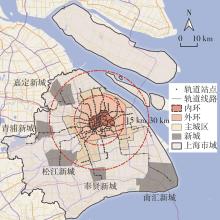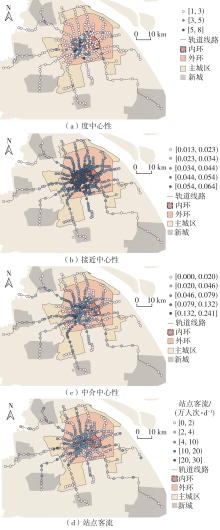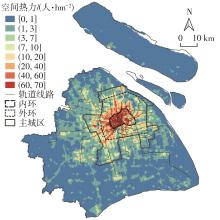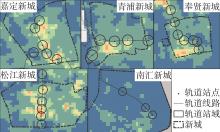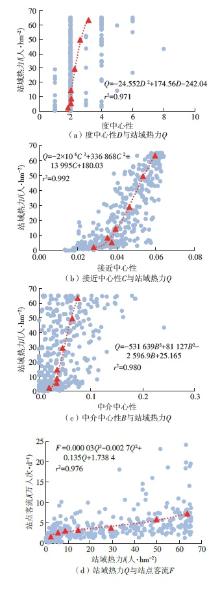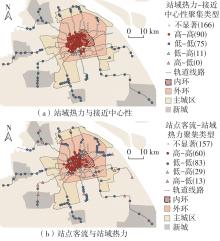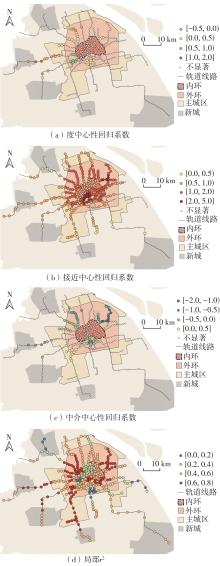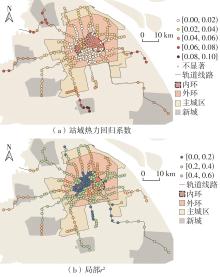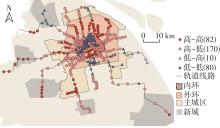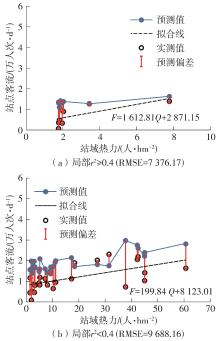| 1 |
吴志强,叶锺楠 .基于百度地图热力图的城市空间结构研究——以上海中心城区为例[J].城市规划,2016,40(4):33-40.
|
|
WU Zhiqiang, YE Zhongnan .Research on urban spatial structure based on Baidu heat map:a case study on the central city of Shanghai[J].City Planning Review,2016,40(4):33-40.
|
| 2 |
郭翰,郭永沛,崔娜娜 .基于多元数据的北京市六环路内昼夜人口流动与人口聚集区研究[J].城市发展研究,2018,25(12):107-112,121.
|
|
GUO Han, GUO Yongpei, CUI Nana .Research on typical population aggregation districts in the Beijing’s Sixth Ring Road based on Baidu’s heat map and points of interest[J].Urban Development Studies,2018,25(12):107-112,121.
|
| 3 |
叶锺楠,陈懿慧 .基于网络数据的轨道交通站点周边空间使用量化研究——以上海地铁10号线沿线为例[J].上海城市规划,2017(6):122-128.
|
|
YE Zhongnan, CHEN Yihui .Quantitative study on space use around urban rail transit station based on network data:a case of Shanghai Metro Line 10[J].Shanghai Urban Planning Review,2017(6):122-128.
|
| 4 |
闵忠荣,丁帆 .基于百度热力图的街道活力时空分布特征分析——以江西省南昌市历史城区为例[J].城市发展研究,2020,27(2):31-36.
|
|
MIN Zhongrong, DING Fan .Analysis of temporal and spatial distribution characteristics of street vitality based on Baidu thermal diagram:the case of the historical city of Nanchang City,Jiangxi Province[J].Urban Development Studies,2020,27(2):31-36.
|
| 5 |
谭章智,李少英,黎夏,等 .城市轨道交通对土地利用变化的时空效应[J].地理学报,2017,72(5):850-862.
|
|
TAN Zhangzhi, LI Shaoying, LI Xia,et al .Spatio-temporal effects of urban rail transit on complex land-use change[J].Acta Geographica Sinica,2017,72(5):850-862.
|
| 6 |
陈弢,潘海啸 .上海轨道交通与人口和就业岗位布局的耦合分析[J].城市规划学刊,2020(5):32-38.
|
|
CHEN Tao, PAN Haixiao .Coupling metro network with household and employment pattern:a case study of Shanghai[J].Urban Planning Forum,2020(5):32-38.
|
| 7 |
吴娇蓉,邓泳淇,陈彩婷 .上海郊区轨道站客流与站域出行活力匹配性研究[J].同济大学学报(自然科学版),2023,51(7):1105-1113.
|
|
WU Jiaorong, DENG Yongqi, CHEN Caiting .Matching degree between ridership and vitality of Shanghai suburban rail sites[J].Journal of Tongji University (Natural Science),2023,51(7):1105-1113.
|
| 8 |
宫同伟 .基于百度热力地图的城市轨道交通站区时空聚集研究[J].统计与决策,2019,35(24):59-63.
|
|
GONG Tongwei .Spatio-temporal population agglomeration in the service areas of urban rail transit stations based on Baidu heat map[J].Statistics & Decision,2019,35(24):59-63.
|
| 9 |
周雨霏,杨家文,周江评,等 .基于热力图数据的轨道交通站点服务区活力测度研究——以深圳市地铁为例[J].北京大学学报(自然科学版),2020,56(5):875-883.
|
|
ZHOU Yufei, YANG Jiawen, ZHOU Jiangping,et al .Evaluating vitality of metro station service area with heat map:a case study on Shenzhen subway[J].Acta Scientiarum Naturalium Universitatis Pekinensis,2020,56(5):875-883.
|
| 10 |
徐益娟,顾大治,孟庆贺 .大数据视角下轨道交通站点空间活力量化及提升策略研究——以合肥轨道交通2号线为例[J].青岛理工大学学报,2022,43(5):48-58.
|
|
XU Yijuan, GU Dazhi, MENG Qinghe .Research on quantification and promotion strategy of spatial vitality of rail transit stations based on big data:a case study of Hefei Rail Transit Line 2[J].Journal of Qingdao University of Technology,2022,43(5):48-58.
|
| 11 |
YANG J W, CAO J, ZHOU Y F .Elaborating non-linear associations and synergies of subway access and land uses with urban vitality in Shenzhen[J].Transportation Research Part A:Policy and Practice,2021,144(2):74-88.
|
| 12 |
潘海啸,任春洋 .轨道交通与城市公共活动中心体系的空间耦合关系——以上海市为例[J].城市规划学刊,2005(4):76-82.
|
|
PAN Haixiao, REN Chunyang .Study on spatial coupling between the metro and urban activity center—case study in Shanghai[J].Urban Planning Forum,2005(4):76-82.
|
| 13 |
曹哲静 .城市商业中心与交通中心的叠合与分异:基于复杂网络分析的东京轨道交通网络与城市形态耦合研究[J].国际城市规划,2020,35(3):42-53.
|
|
CAO Zhejing .Configuration of urban commercial centers and transport centers:evidence from Tokyo transit network and urban morphology based on the complex network analysis[J].Urban Planning International,2020,35(3):42-53.
|
| 14 |
王玉萍,陈宽民,马超群 .城市轨道交通网络与城市形态协调性的量化分析[J].铁道工程学报,2008(11):11-15.
|
|
WANG Yu-ping, CHEN Kuan-min, MA Chao-qun .Quantitative analysis of coordination between rail transit network configuration and urban form[J].Journal of Railway Engineering Society,2008(11):11-15.
|
| 15 |
史瑞利 .北京市轨道交通网络与人口分布协调发展研究[D].北京:北京交通大学,2016.
|
| 16 |
BERTOLINI L .Nodes and places:complexities of railway station redevelopment[J].European Planning Studies,1996,4(3):331-345.
|
| 17 |
CAO Z J, ASAKURA Y, TAN Z B .Coordination between node,place,and ridership:comparing three transit operators in Tokyo[J].Transportation Research Part D:Transport and Environment,2020,87(10):102518/1-19.
|
| 18 |
张志健,高顺祥,陈越,等 .基于改进节点-场所模型的城市轨道交通TOD评估[J].交通运输研究,2022,8(3):143-153,165.
|
|
ZHANG Zhi-jian, GAO Shun-xiang, CHEN Yue,et al .Evaluation of urban rail transit TOD based on enhanced node-place model[J].Transport Research,2022,8(3):143-153,165.
|
| 19 |
周青峰,刘苏,王耀武 .城市轨道交通站点周边土地利用与交通协调关系研究[J].铁道运输与经济,2018,40(4):100-106.
|
|
ZHOU Qing-feng, LIU Su, WANG Yao-wu .A study on the coordinative relation of land use and transport around the metro station[J].Railway Transport and Economy,2018,40(4):100-106.
|
| 20 |
刘泉 .轨道站点地区TOD规划管理中的指标控制[J].规划师,2018,34(1):48-58.
|
|
LIU Quan .Indices control of TOD planning management[J].Planners,2018,34(1):48-58.
|
| 21 |
白同舟,蔡乐,朱家正,等 .轨道交通与城市协同发展的空间差异性分析:以北京市为例[J].交通运输系统工程与信息,2020,20(3):14-19.
|
|
BAI Tong-zhou, CAI Le, ZHU Jia-zheng,et al .Spatial differentiation of rail transit and urban development coordination:a case study of Beijing[J].Journal of Transportation Systems Engineering and Information Technology,2020,20(3):14-19.
|
| 22 |
王亚洁 .国外城市轨道交通与站域土地利用互动研究进展[J].国际城市规划,2018,33(1):111-118.
|
|
WANG Yajie .International studies on the interaction between urban rail transit and land use of station areas[J].Urban Planning International,2018,33(1):111-118.
|
| 23 |
韩寒 .深圳市轨道交通结构与商业活力空间关联分析[J].经济地理,2021,41(3):86-96.
|
|
HAN Han .Spatial correlation between rail transit structure and commercial vitality in Shenzhen[J].Economic Geography,2021,41(3):86-96.
|
| 24 |
宋成镇,陈延斌,殷冠文,等 .交通网络中心性与土地利用强度的相关性及空间异质性研究——以青岛市主城区为例[J].西安理工大学学报,2022,38(2):201-211.
|
|
SONG Chengzhen, CHEN Yanbin, YIN Guanwen,et al .Correlation and spatial heterogeneity between road network centrality and land use intensity:a case study of Qingdao City[J].Journal of Xi’an University of Technology,2022,38(2):201-211.
|
| 25 |
张海林 .基于百度热力图的人口活动数量提取与规划应用[J].城市交通,2021,19(3):103-111.
|
|
ZHANG Hailin .Extracting active population data based on Baidu heat maps for transportation planning applications[J].Urban Transport of China,2021,19(3):103-111.
|
| 26 |
谭欣,黄大全,赵星烁,等 .基于百度热力图的职住平衡度量研究[J].北京师范大学学报(自然科学版),2016,52(5):622-627.
|
|
TAN Xin, HUANG Daquan, ZHAO Xingshuo,et al .Jobs housing balance based on Baidu thermodynamic diagram[J].Journal of Beijing Normal University(Natural Science),2016,52(5):622-627.
|
| 27 |
SHI Z B, ZHANG N, LIU Y,et al .Exploring spatiotemporal variation in hourly metro ridership at station level:the influence of built environment and topological structure[J].Sustainability,2018,10(12):4564/1-16.
|
| 28 |
孔祥夫,杨家文 .土地利用视角下的轨道站点客流预测——以深圳市为例[J].地理科学,2018,38(12):2074-2083.
|
|
KONG Xiangfu, YANG Jiawen .A new method for forecasting station-level transit ridership from land-use perspective:the case of Shenzhen City[J].Scientia Geographica Sinica,2018,38(12):2074-2083.
|
 ), CHEN Caiting1, DENG Yongqi2
), CHEN Caiting1, DENG Yongqi2
